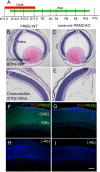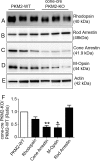Pyruvate kinase M2 isoform deletion in cone photoreceptors results in age-related cone degeneration
- PMID: 29970877
- PMCID: PMC6030055
- DOI: 10.1038/s41419-018-0712-9
Pyruvate kinase M2 isoform deletion in cone photoreceptors results in age-related cone degeneration
Abstract
The tumor form of pyruvate kinase M2 has been suggested to promote cellular anabolism by redirecting the metabolism to cause accumulation of glycolytic intermediates and increasing flux through the pentose phosphate pathway, which is a metabolic pathway parallel to glycolysis. Both rod and cone photoreceptors express the tumor form of pyruvate kinase M2. Recent studies from our laboratory show that PKM2 is functionally important for rod photoreceptor structure, function, and viability. However, the functional role of PKM2 in cones is not known. In this study, we conditionally deleted PKM2 in cones (cone-cre PKM2-KO) and found that loss of PKM2 results in the upregulation of PKM1 and a significant loss of cone function and cone degeneration in an age-dependent manner. Gene expression studies on cone-cre PKM2-KO show decreased expression of genes regulating glycolysis, PPP shunt, and fatty acid biosynthesis. Consistent with these observations, cones lacking PKM2 have significantly shorter cone outer segments than cones with PKM2. Our studies clearly suggest that PKM2 is essential for the anabolic process in cones to keep them alive for normal functioning and to support cone structure.
Conflict of interest statement
The authors declare that they have no conflict of interest.
Figures










Similar articles
-
Pyruvate kinase M2 regulates photoreceptor structure, function, and viability.Cell Death Dis. 2018 Feb 14;9(2):240. doi: 10.1038/s41419-018-0296-4. Cell Death Dis. 2018. PMID: 29445082 Free PMC article.
-
M-Type Pyruvate Kinase Isoforms and Lactate Dehydrogenase A in the Mammalian Retina: Metabolic Implications.Invest Ophthalmol Vis Sci. 2016 Jan 1;57(1):66-80. doi: 10.1167/iovs.15-17962. Invest Ophthalmol Vis Sci. 2016. PMID: 26780311
-
Small molecule activation of metabolic enzyme pyruvate kinase muscle isozyme 2, PKM2, circumvents photoreceptor apoptosis.Sci Rep. 2020 Feb 19;10(1):2990. doi: 10.1038/s41598-020-59999-w. Sci Rep. 2020. PMID: 32076076 Free PMC article.
-
Pyruvate kinase: Function, regulation and role in cancer.Semin Cell Dev Biol. 2015 Jul;43:43-51. doi: 10.1016/j.semcdb.2015.08.004. Epub 2015 Aug 13. Semin Cell Dev Biol. 2015. PMID: 26277545 Free PMC article. Review.
-
Pyruvate Kinase M2: A Potential Regulator of Cardiac Injury Through Glycolytic and Non-glycolytic Pathways.J Cardiovasc Pharmacol. 2024 Jul 1;84(1):1-9. doi: 10.1097/FJC.0000000000001568. J Cardiovasc Pharmacol. 2024. PMID: 38560918 Free PMC article. Review.
Cited by
-
Ciliary neurotrophic factor-mediated neuroprotection involves enhanced glycolysis and anabolism in degenerating mouse retinas.Nat Commun. 2022 Nov 17;13(1):7037. doi: 10.1038/s41467-022-34443-x. Nat Commun. 2022. PMID: 36396639 Free PMC article.
-
Modulating GLUT1 expression in retinal pigment epithelium decreases glucose levels in the retina: impact on photoreceptors and Müller glial cells.Am J Physiol Cell Physiol. 2019 Jan 1;316(1):C121-C133. doi: 10.1152/ajpcell.00410.2018. Epub 2018 Nov 21. Am J Physiol Cell Physiol. 2019. PMID: 30462537 Free PMC article.
-
Imbalance in Glucose Metabolism Regulates the Transition of Microglia from Homeostasis to Disease-Associated Microglia Stage 1.J Neurosci. 2024 May 15;44(20):e1563232024. doi: 10.1523/JNEUROSCI.1563-23.2024. J Neurosci. 2024. PMID: 38565291 Free PMC article.
-
Selective knockdown of hexokinase 2 in rods leads to age-related photoreceptor degeneration and retinal metabolic remodeling.Cell Death Dis. 2020 Oct 20;11(10):885. doi: 10.1038/s41419-020-03103-7. Cell Death Dis. 2020. PMID: 33082308 Free PMC article.
-
Aerobic Glycolysis in the Retina: Functional Roles of Pyruvate Kinase Isoforms.Front Cell Dev Biol. 2020 Apr 30;8:266. doi: 10.3389/fcell.2020.00266. eCollection 2020. Front Cell Dev Biol. 2020. PMID: 32426353 Free PMC article. Review.
References
-
- Bok D. Retinal photoreceptor-pigment epithelium interactions. Friedenwald lecture. Invest Ophthalmol. Vis. Sci. 1985;26:1659–1694. - PubMed
Publication types
MeSH terms
Substances
Grants and funding
LinkOut - more resources
Full Text Sources
Other Literature Sources
Molecular Biology Databases
Research Materials
Miscellaneous

